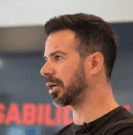
The Commitment Ladder: How to Turn More Leads Into Meetings

Last Updated
Sep 18, 2025

by Pietro Zancuoghi
COO, Scale Labs
Every interaction with a potential client is a step toward (or away from) building trust. The Commitment Ladder is a framework that helps sales teams guide leads from low-friction touchpoints (like emails) to high-focus conversations (like meetings and in-person visits).
In this article, we’ll break down how the ladder works, why it’s effective, and how you can apply it to boost your response rates, show-up rates, and revenue.
What Is the Commitment Ladder?
The Commitment Ladder is the idea that each channel you use to reach leads has different levels of scale, focus, and time investment.
Lower rungs (like email) are scalable but less focused.
Higher rungs (like in-person visits) are more focused but require more time and cost.
The play is simple:
1. Start broad.
2. Earn attention with small, low-friction “micro-yeses.”
3. Escalate quickly into the channel where the lead actually responds.
Why the Commitment Ladder Works
There are four main levers that make this framework effective:
Availability – Some channels are easier to reach leads in real-time (e.g., SMS vs. email).
Speed – Texts and direct messages are often read within minutes, while emails can take hours or days.
Personalization – Personalized outreach beats generic automation almost every time.
Volume – High-scale channels like email help you start broad, but you need to move up the ladder to close.
Industry benchmarks back this up:
Email: Average open rates hover around 30–40%, with reply rates typically under 10%.
SMS: Nearly all texts are opened, and replies are much faster.
Calls: Direct phone contact remains one of the fastest ways to move a deal forward.
Meetings: Automated reminders can cut no-shows by up to 28%.
The 5 Steps of the Commitment Ladder
Step 1: Email (Low Friction, High Scale)
Use short, direct prompts to spark a reply.
Example: “Are you still looking to grow your [4-word outcome]?”
Goal: Get a reply to identify the preferred channel.
Step 2: Messages (DM/SMS)
Personal video, voice note, or a single personalized line works best.
Faster responses mean you can quickly propose a same-day call.
Goal: Qualify and book a call window.
Step 3: Calls
Use a double-dial strategy. Leave a quick voicemail and send an immediate follow-up text.
Goal: Live connect or pull an appointment forward (today > tomorrow).
Step 4: Online Meetings
Front-load reminders: send at 24h, 12h, 3h before, plus manual check-ins the night before and morning of.
Goal: Maximize show-up rate and get decisions made.
Step 5: In-Person Visits
Highest cost and highest focus.
Use only when average contract value (ACV) and geography justify it.
Goal: Build deep trust and accelerate closing.
How to Run the Commitment Ladder in Practice
1. Multichannel From Day 0
Don’t wait to try one channel at a time. On the first day, hit email, SMS/DM, and calls all at once.
2. Front-Load Your Efforts
The first 72 hours matter most. Run multiple touches early to capture attention while intent is high.
3. Use Automation Where It Matters
Automate reminders, email sequences, and scheduling and personalize where it counts (first touches, messages, and calls).
4. Always BAMFAM (Book a Meeting From a Meeting)
Don’t end a call without booking the next step. Keep the momentum moving up the ladder.
The Commitment Ladder is about matching scale, focus, and investment to where your lead is most likely to respond.
If you:
Start broad,
Escalate quickly,
And use reminders to drive show-ups…
…you’ll not only book more meetings but also close deals faster.
FAQs About the Commitment Ladder
1. How many touches should I make before stopping?
Most sales teams see results with 6-10 touches over 7-10 days. If there’s no reply, move the lead into long-term nurture.
2. Why not just focus on email?
Because email is high scale but low focus. Open rates may look healthy, but response rates are far lower. That’s why escalation to calls, SMS, and meetings is critical.
3. How do I reduce meeting no-shows?
Send a reminder stack (24h, 12h, 3h, morning-of, 60 min prior). Include details like time, date, and the number you’ll call from. Tools like Calendly or HubSpot help automate this.
4. When should I use in-person visits?
Use them only when the potential deal size justifies the higher time and travel cost, typically for high-value accounts or enterprise clients.
5. Can I automate the entire ladder?
No. Automation works for scale, but personalization drives responses. Use automation to handle volume, and layer personalization where it matters most.
Resources
Get free insights straight from our R&D department
Resources
B2B Sales Training: How To Train Your Team To Sell More
Recent reports on B2B sales training and coaching show that top performing teams treat training as a continuous system, not a one off event. They combine foundational knowledge, practical exercises, coaching and data driven feedback. This article outlines how to design sales training that actually changes behaviour and results.
Read More ->
Nov 27, 2025

by Pietro Zancuoghi
COO, Scale Labs
Resources
The Importance Of Sales Metrics In B2B: What To Track And Why It Matters
This article explains which metrics matter most in B2B and how to use them in a practical way.
Read More ->
Nov 20, 2025

by Pietro Zancuoghi
COO, Scale Labs
Resources
Essential Principles In B2B Selling: Active Listening, Adaptation And Clear Communication
Modern consultative selling frameworks consistently highlight a few timeless principles: asking good questions, active listening, tailoring your approach and communicating clearly in the buyer’s interest. This article will walk through the essential principles you can apply immediately in your B2B sales conversations.
Read More ->
Nov 13, 2025

by Pietro Zancuoghi
COO, Scale Labs



